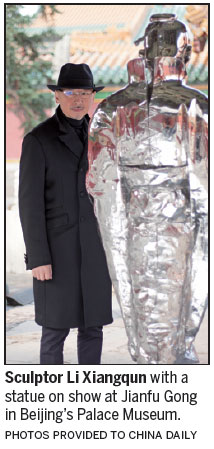Sculptor's works rekindle links with cultural icons
Chinese sculptor Li Xiangqun, 55, brings to life ancient Chinese cultural icons, such as Su Dongpo, the Song Dynasty (960-1279) writer and statesman. He does this to bring these distant figures closer to modern-day Chinese.
The Beijing-based artist's works produced earlier this year include four statues portraying "Four Masters of the Yuan Dynasty (1271-1368)". The collective term refers to Huang Gongwang, Wang Meng, Wu Zhen and Ni Zan, imperial painters who are revered to this day as exponents of the Chinese literati painting style.
He depicts the four figures differently, interpreting the lives of these ancient Chinese artists and scholars.
For instance, the statue of Huang (pictured left) shows him with rolled up sleeves reaching out his right hand as if he is about to paint, but he does not have a brush because Li says he wants to emphasize the manner of the icon, rather than the technique which distinguished Huang from his generation of artists.
The statue of Wang shows him relaxing in a chair to convey a Zen feeling and a reclusive temperament, which Li believes was central to the life philosophy of the ancient Chinese.
Li donated the statues to the Palace Museum in Beijing, which houses the four masters' artworks, at the opening of his solo exhibition on Nov 11 at the former royal palace of the Ming (1368-1644) and the Qing (1644-1911) dynasties.
Besides the four statues, the exhibition titled City vs Phenomenon, which runs through Saturday also showcases several of Li's sculptures crafted since 2012, in the palace's Jianfu Gong, or the Garden of Established Happiness.
The garden, which was destroyed in a fire in 1923 and restored in 1974, epitomizes classic Chinese gardening. A separate project between 2000 to 2005 saw its pavilions being rebuilt. Meanwhile, remnants of the original buildings are seen scattered in the garden.
Li says exhibiting in Jianfu Gong's classical courtyards was challenging. "The spacious environment boasts rich color tones because of the architecture and the trees, and therefore, the artworks would look rather small and even be 'eaten up' (disappear into the background)."
Also, because of the uneven bricked ground that has survived several centuries, he had to choose carefully how and where to place the works.

Li's solution was to use white bronze as the material for his works, and to polish the surface to achieve a mirrorlike effect. The figures are installed on a stainless steel base.
"The smooth processed white bronze gives the works a strong industrial feel - creating a contrast with the surrounding wooden pavilions, walls and bricked tiles, which are the epitome of Chinese cultural traditions."
He also says that the reflective surface mirrors all the objects around, including the audience and their clothes, by which the works are merged into the environment.
"The viewers thus become part of the works, and the moving images they see on each work form a contrast with the silence of the garden where time seems frozen."
Zhang Zikang, the exhibition's curator, says Li's approach is abstract, as he attempts to detach the figures he sculpts from the specific periods of history they lived in - highlighting their characters so that they are vivid to viewers today.
Among the works on show is a sculpture of Confucius standing on a long, reflective plate of stainless steel, produced four years ago.
Li compares the plate to a paper sheet of historical records rolling out behind Confucius, a politician and philosopher of the Spring and Autumn Periods (770-476 BC), indicating the inheritance of philosophical thoughts since Confucius' time.
Another work is called Great Forbidden City. It is a sculpture comprising 25 parts and modeled after the palace's buildings. He first showed it at his solo exhibition at Beijing's National Museum of Art in 2012.
It is now placed under pine trees in the garden's southern courtyard. Its delicate quality forms a contrast with the cracked red walls and overgrown weeds. At the opening ceremony, there was a modern dance performance at its base.
Speaking about the piece, he says: "I first visited the Palace Museum when I was a junior (at the Luxun Academy of Fine Arts in Shenyang, in Northeast China's Liaoning province). I was then overwhelmed by its imposing aura.
"This sculpture can be seen as the brain of the Forbidden City. It is a statue of power through which I hope to evoke people's appreciation of our history and culture."
linqi@chinadaily.com.cn


















